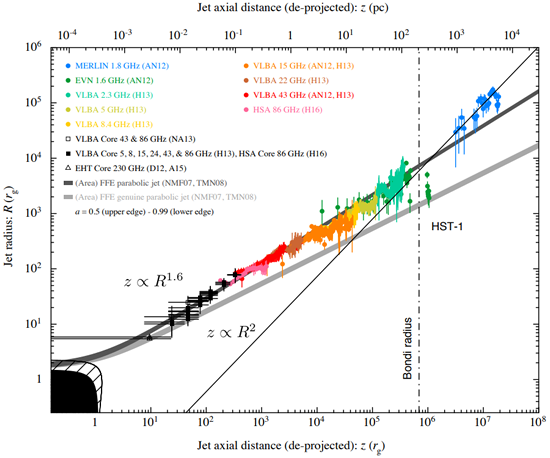Parabolic Streamline of the Black Hole-driven Jet from ten to million gravitational radii in M87

Multi-wavelength VLBI observations (Asada & Nakamura 2012; Nakamura & Asada 2013; Asada, Nakamura, & Pu 2016) reveal the collimating jet profile inside the sphere of gravitational influence of the supermassive black hole in M87. Here, we demonstrate a direct comparison between the observation and theory. Distribution of the jet radius R as a function of the jet axial distance z (de-projected with M_BH = 6.2 × 10^9 M_sun and θ_view = 14 deg.) from the SMBH in units of r_g.The (vertical) dashed-dotted line denotes the Bondi radius, located at ~ 7 ×10^5 r_g and the HST-1 complex is around 10^6 r_g. Filled black region denotes the black hole (inside the event horizon), while the hatched area represents the ergosphere for the spin parameter a = 0.99. The light gray area denotes the approximate solution of the force-free genuine parabolic jet (outermost Blandford & Znajek (1977)-type streamline: z ~ R^2), while the dark gray area is the case of the parabolic jet (outermost Blandford & Payne (1982)-type streamline: z ~ R^1.6), respectively. In both of the outermost streamlines, which are anchored to the event horizon, a variation of the Kerr parameter from a = 0.5 (upper edge) to a = 0.99 (lower edge) is represented as a shaded area. Our examination suggests that the M87 jet is presumably originated from the spinning black hole (BZ77 mechanism), but it is shaped into a BP82 type configuration. Our hypothesis will be tested by the Event Horizon Telescope Project including the GLT pretty soon.